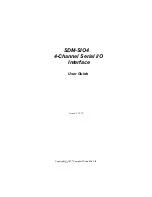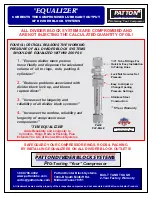
Section 1 . Introduction
1-3
1.2
Specifications
1.2.1
Serial Ports
The SDM-SIO4 has four serial ports which can be configured independently
to use different serial data formats and baud rates (from 25 to 115,200
baud). These ports are 0-5V logic or ±5V for RS232 and are configured
similar to a PC ‘AT’ style DTE serial port.
Handshaking, to control the flow of data to and from a sensor, can be done
by the datalogger or SDM-SIO4 if needed, and can be in the form of
hardware or software protocols.
Table 1 SDM-SIO4 Serial Port Pin Configuration
Pin No.
SDM-SIO4 Port
1.
RI ring indicate/DCD in
2.
RX in
3.
TX out
4.
DTR data terminal ready out
5.
Ground
6.
DSR in
7.
RTS request to send out
8.
CTS clear to send in
9.
+5V if internal link fitted, otherwise no connection
If you have an older SDM-SIO4 which has female ‘D’ type
connectors, your connections will be different from those
shown above. Please either refer to your earlier Manual or
contact Campbell Scientific for further details.
Serial Port Buffers
Each serial port has a receive (Rx) buffer, a transmit (Tx) buffer and a
processed data storage buffer. It is important to understand these buffers as
their size can determine how often data must be collected from the
SDM-SIO4 by the datalogger. It is important to avoid letting these buffers
fill up. They are of the ‘fill and stop’ type, i.e. if they fill up, and more data
is sent into the buffer, the extra data will be lost.
The receive and transmit buffers for each port are 981 bytes long and there
is an additional 16-byte hardware buffer for each port.
The processed data storage buffer (used to store converted data ready for the
datalogger to collect) is 891 bytes long, which is large enough for 222 4-
byte Campbell Scientific floating point values (refer to the datalogger
manual for more details of this format).
There is one more buffer, which is used only when the datalogger outputs
floating point data via the SDM-SIO4. This buffer is 241 bytes — long
enough for 60 floating point values. (The size of this buffer is rarely a
limitation as it is emptied quickly.)
NOTE










































